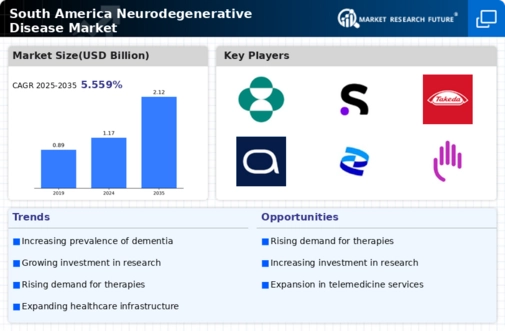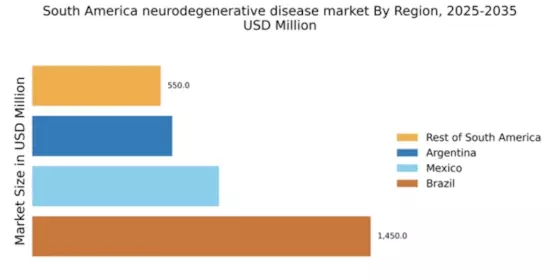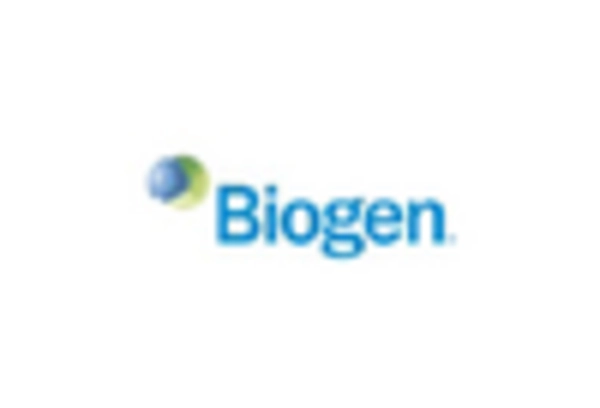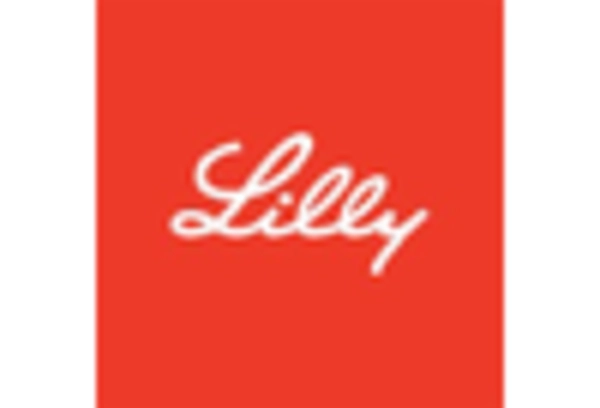Aging Population in South America
The aging population in South America is a critical driver for the neurodegenerative disease market. As life expectancy increases, the incidence of neurodegenerative disorders such as Alzheimer's and Parkinson's disease is expected to rise. By 2030, it is projected that the population aged 65 and older will account for approximately 15% of the total population in South America. This demographic shift creates a growing demand for effective treatments and care solutions within the neurodegenerative disease market. Furthermore, the increasing burden on healthcare systems necessitates innovative approaches to manage these conditions, thereby driving investment in research and development. The economic implications are substantial, with potential costs related to care and treatment reaching billions of dollars annually, highlighting the urgency for advancements in this sector.
Increased Awareness and Education
Increased awareness and education regarding neurodegenerative diseases significantly impact the neurodegenerative disease market in South America. Public health campaigns and educational initiatives have led to a better understanding of these conditions among both healthcare professionals and the general population. This heightened awareness encourages early diagnosis and intervention, which is crucial for effective management of neurodegenerative disorders. As a result, there is a growing demand for diagnostic tools and therapeutic options, contributing to market expansion. Moreover, the emphasis on patient education empowers individuals to seek medical advice sooner, potentially improving outcomes. The market is likely to see a surge in innovative products and services tailored to meet the needs of an informed patient population, further driving growth in this sector.
Investment in Healthcare Infrastructure
Investment in healthcare infrastructure is a pivotal driver for the neurodegenerative disease market in South America. Governments and private entities are increasingly recognizing the need to enhance healthcare facilities and services to address the rising prevalence of neurodegenerative disorders. This investment includes the establishment of specialized clinics, research centers, and rehabilitation facilities aimed at improving patient care. For instance, funding for research initiatives has seen a notable increase, with allocations reaching millions of dollars annually. Enhanced infrastructure not only facilitates better access to care but also fosters collaboration between researchers and clinicians, leading to advancements in treatment options. As healthcare systems evolve, the neurodegenerative disease market is poised for growth, driven by improved service delivery and innovative therapeutic solutions.
Technological Advancements in Treatment
Technological advancements in treatment modalities are transforming the neurodegenerative disease market in South America. Innovations such as telemedicine, artificial intelligence, and personalized medicine are reshaping how these disorders are diagnosed and managed. For example, telehealth services have expanded access to specialists, allowing patients in remote areas to receive timely consultations. Additionally, the integration of AI in drug discovery processes is accelerating the development of new therapies, potentially leading to breakthroughs in treatment. The market is witnessing a shift towards more targeted and effective interventions, which could improve patient outcomes significantly. As these technologies continue to evolve, they are likely to attract investment and drive competition within the neurodegenerative disease market, fostering a dynamic environment for growth.
Rising Economic Burden of Neurodegenerative Diseases
The rising economic burden of neurodegenerative diseases is a significant driver for the neurodegenerative disease market in South America. As the prevalence of these disorders increases, the associated healthcare costs are expected to escalate dramatically. Estimates suggest that the economic impact of neurodegenerative diseases could reach billions of dollars annually, encompassing direct medical expenses and indirect costs such as lost productivity. This financial strain on families and healthcare systems underscores the urgent need for effective treatments and preventive measures. Policymakers are likely to prioritize funding for research and development in this area, aiming to alleviate the economic burden while improving patient care. Consequently, the neurodegenerative disease market may experience accelerated growth as stakeholders seek solutions to address this pressing issue.


















Leave a Comment